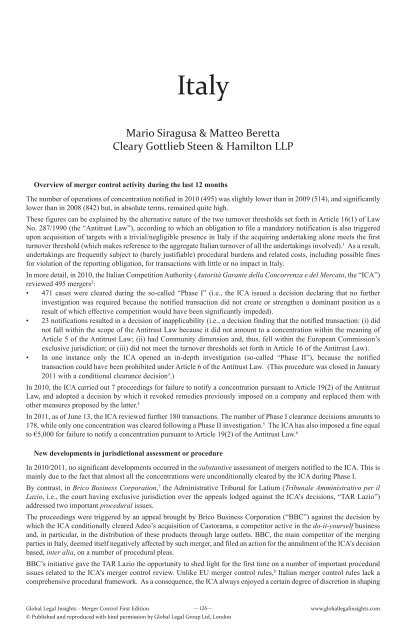Merger Controls First Edition - J Sagar Associates
Merger Controls First Edition - J Sagar Associates
Merger Controls First Edition - J Sagar Associates
You also want an ePaper? Increase the reach of your titles
YUMPU automatically turns print PDFs into web optimized ePapers that Google loves.
Italy<br />
Mario Siragusa & Matteo Beretta<br />
Cleary Gottlieb Steen & Hamilton LLP<br />
Overview of merger control activity during the last 12 months<br />
The number of operations of concentration notified in 2010 (495) was slightly lower than in 2009 (514), and significantly<br />
lower than in 2008 (842) but, in absolute terms, remained quite high.<br />
These figures can be explained by the alternative nature of the two turnover thresholds set forth in Article 16(1) of Law<br />
No. 287/1990 (the “Antitrust Law”), according to which an obligation to file a mandatory notification is also triggered<br />
upon acquisition of targets with a trivial/negligible presence in Italy if the acquiring undertaking alone meets the first<br />
turnover threshold (which makes reference to the aggregate Italian turnover of all the undertakings involved). 1 As a result,<br />
undertakings are frequently subject to (barely justifiable) procedural burdens and related costs, including possible fines<br />
for violation of the reporting obligation, for transactions with little or no impact in Italy.<br />
In more detail, in 2010, the Italian Competition Authority (Autorità Garante della Concorrenza e del Mercato, the “ICA”)<br />
reviewed 495 mergers2 :<br />
• 471 cases were cleared during the so-called “Phase I” (i.e., the ICA issued a decision declaring that no further<br />
investigation was required because the notified transaction did not create or strengthen a dominant position as a<br />
result of which effective competition would have been significantly impeded).<br />
• 23 notifications resulted in a decision of inapplicability (i.e., a decision finding that the notified transaction: (i) did<br />
not fall within the scope of the Antitrust Law because it did not amount to a concentration within the meaning of<br />
Article 5 of the Antitrust Law; (ii) had Community dimension and, thus, fell within the European Commission’s<br />
exclusive jurisdiction; or (iii) did not meet the turnover thresholds set forth in Article 16 of the Antitrust Law).<br />
• In one instance only the ICA opened an in-depth investigation (so-called “Phase II”), because the notified<br />
transaction could have been prohibited under Article 6 of the Antitrust Law. (This procedure was closed in January<br />
2011 with a conditional clearance decision3 .)<br />
In 2010, the ICA carried out 7 proceedings for failure to notify a concentration pursuant to Article 19(2) of the Antitrust<br />
Law, and adopted a decision by which it revoked remedies previously imposed on a company and replaced them with<br />
other measures proposed by the latter. 4<br />
In 2011, as of June 13, the ICA reviewed further 180 transactions. The number of Phase I clearance decisions amounts to<br />
178, while only one concentration was cleared following a Phase II investigation. 5 The ICA has also imposed a fine equal<br />
to €5,000 for failure to notify a concentration pursuant to Article 19(2) of the Antitrust Law. 6<br />
New developments in jurisdictional assessment or procedure<br />
In 2010/2011, no significant developments occurred in the substantive assessment of mergers notified to the ICA. This is<br />
mainly due to the fact that almost all the concentrations were unconditionally cleared by the ICA during Phase I.<br />
By contrast, in Brico Business Corporation, 7 the Administrative Tribunal for Latium (Tribunale Amministrativo per il<br />
Lazio, i.e., the court having exclusive jurisdiction over the appeals lodged against the ICA’s decisions, “TAR Lazio”)<br />
addressed two important procedural issues.<br />
The proceedings were triggered by an appeal brought by Brico Business Corporation (“BBC”) against the decision by<br />
which the ICA conditionally cleared Adeo’s acquisition of Castorama, a competitor active in the do-it-yourself business<br />
and, in particular, in the distribution of these products through large outlets. BBC, the main competitor of the merging<br />
parties in Italy, deemed itself negatively affected by such merger, and filed an action for the annulment of the ICA’s decision<br />
based, inter alia, on a number of procedural pleas.<br />
BBC’s initiative gave the TAR Lazio the opportunity to shed light for the first time on a number of important procedural<br />
issues related to the ICA’s merger control review. Unlike EU merger control rules, 8 Italian merger control rules lack a<br />
comprehensive procedural framework. As a consequence, the ICA always enjoyed a certain degree of discretion in shaping<br />
Global Legal Insights <strong>Merger</strong> Control <strong>First</strong> <strong>Edition</strong><br />
—126—<br />
© Published and reproduced with kind permission by Global Legal Group Ltd, London<br />
www.globallegalinsights.com


